Palamidi
| The fort of the Palamidi, which has been preserved in excellent condition, is one of the greatest achievements of Venetian fortification architecture.
The hill of Palamidi, which takes its name from the Homeric hero Palamidis, does not seem to have been systematically fortified until the second Venetian occupation. The construction of the fort was basically carried out during the time of Venetian General Superintendent of the Fleet, Agostino Sagredo, from 1711 to 1714, marking the fort not only as a major feat in terms of its fortifications, but also in terms of the speed with which it was constructed. The engineers Giaxich and Lasalle designed a fort that was based on a system of mutually supporting and mutually defending bastions, which are built one above the other on a east-west axis, and are connected to each other by a wall. The total of eight bastions are self contained so that if one of them was breached, the rest could continue their defence. |
||
 |
||
|
The central bastion of Aghios Andreas was the main headquarters and was the best equipped. The chapel of Aghios Andreas is located here. It was originally consecrated to St Gerardo, the patron saint of the Sagredo family. It should be noted that the names of the bastions changed according to the occupants of the fort. Apart from the bastion of Aghios Andreas, the Venetians also built: the bastions of Leonidas and Miltiadis to the north, Robert to the northwest, Themistocles to the south and Achilles to the east. The bastion of Epameinondas was completed during the time of the Turkish occupation, while Fokion was built entirely by the Turks. It should be noted that during the time of the Turkish occupation, Christians were not allowed to enter the fort. |
||
|
It was from the Palamidi that the liberation of the city from the Turks began, after a long siege. On the night of 29th November 1822, a unit of Greek rebels, led by Staikos Staikopoulos, launched a surprise attack and seized the Palamidi. Dimitrios Moschonisiotis was the first to set foot inside the fort from the bastion of Achilles.
At noon on 30th November, once the debris had been hastily cleared away from the abandoned chapel, which had been consecrated to St Gerardo, a service of thanks and praise was held and the chapel has since then been consecrated to the Apostle Andreas, as his feast day is celebrated on this day; the day Nauplion became Greek.
From then on, every year on this date the liberation of the city is celebrated with a service in this historic chapel. |
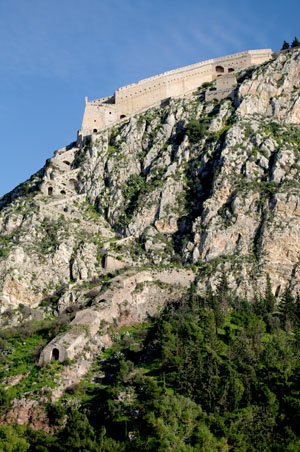 |
|
| Not only was the Palamidi a great fortress, it was also the site of a dismal prison. In 1833, during the time of the regency, when King Otto was still a minor, one of the leaders of the revolution, Theodoros Kolokotronis, was imprisoned here on the supposed charge of high treason.
The Miltiadis bastion, one of the largest, was converted into a prison for serious criminals in around 1840, and it remained in operation until around 1926. The Aghios Andreas bastion was also used as a prison, but conditions here were somewhat better. |
||
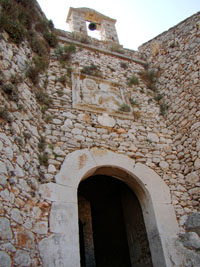 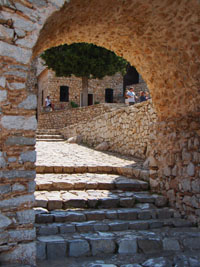  |
||
|
Today, the fort can be accessed either by the road which terminates at the eastern gate or by the famous steps which are located on the western side to the east of the Grimani bastion. These steps are traditionally supposed to number 999, the thousandth having been destroyed by Kolokotronis' horse. However, in reality there are less and they were constructed during Otto's reign by prisoners who were held in the Palamidi, under the supervision of the Bavarian army. From here there is an excellent view of the castle of the Acronauplia. |
||
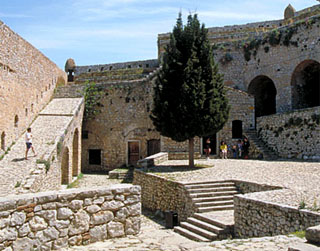 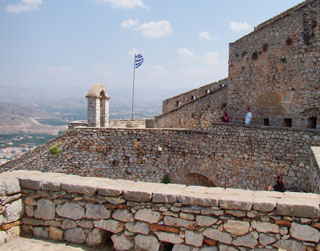 |
||
|
Once in the fort one can see, among other things, the imposing bastions, the historic chapel of Aghios Andreas and the impressive water tanks, which even today are used to collect rainwater. The exact location of Palamidi can be found in Section Map. |
||
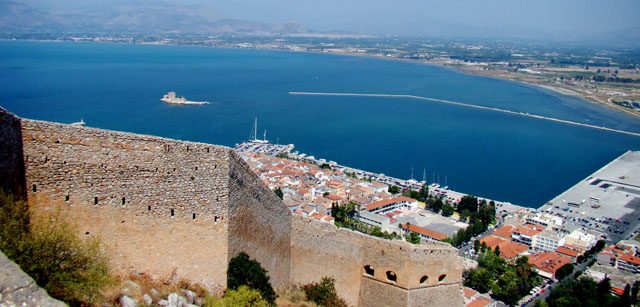 |
||


